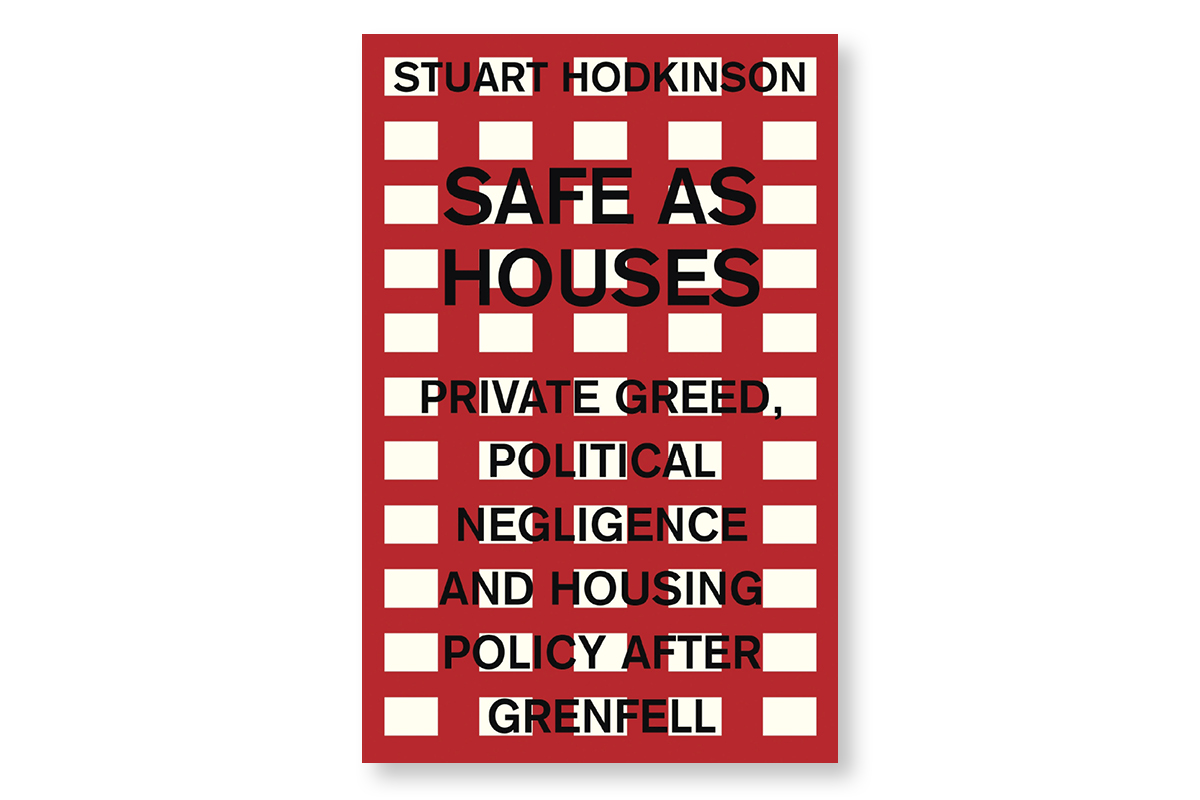You are viewing 1 of your 1 free articles
Did the private finance initiative contribute to the culture that led to Grenfell?
A new book by Professor Stuart Hodkinson lifts the lid on three housing private finance initiative deals gone wrong and argues that the shortcomings in these schemes augured Grenfell. Peter Apps reviews the book, alongside an abridged extract. Photography: Rex Features
Safe as Houses: Private Greed, Political Negligence and Housing Policy After Grenfell was written by Dr Stuart Hodkinson, lecturer in critical urban geography, and published in March.
Dr Hodkinson, who is experienced in working with residents’ groups in council regeneration projects, looks at the private finance initiative (PFI), regulation and resident action and argues that this created the background that allowed the Grenfell Tower tragedy to happen.
Below is a review and an explanation of the book by Inside Housing’s deputy editor Peter Apps, followed by an extract from the book itself, in which Dr Hodkinson describes the history of PFIs in London.
A review of Safe as Houses by Peter Apps, deputy editor of Inside Housing:
The first thing to understand about this book is that it is primarily not about Grenfell Tower.
Instead, as the author Stuart Hodkinson, lecturer in critical urban geography at the University of Leeds, notes in the opening pages, the book is a write-up of “a decade of research” concerning “unsafe and unjust regeneration schemes”.
Grenfell provides the backdrop – the ultimate warning of what can go wrong when large construction projects in social housing fail – but the majority of the book is concerned with three other projects in London: the Chalcots Estate refurbishment in Camden, the Myatts Field North regeneration in Lambeth and a major project covering the repair and refurbishment of thousands of street properties in Islington.
The common theme for all three of these is that they are funded through PFI models, which is the real subject of the author’s ire and the ultimate theme of the book.
“In its best sections, the book is methodical and damning. It is also angry – shot through with first-hand accounts from residents who have experienced the sharp end of the alleged failings”
Professor Hodkinson explains in detail the cost to the public purse and the way money has, he argues, been bled out of the public sector to produce results that are far from what was first promised.
In its best sections, the book is methodical and damning. It is also angry – shot through with first-hand accounts from residents who have experienced the sharp end of the alleged failings.
It is hard not to share this frustration when reading, for example, the story of Myatts Field North’s transformation into ‘Oval Quarter’, the glossy new branding it was given to attract buyers of its private homes, contrasted with the experiences of those who lived on the estate.
Overall this is the clearest explanation of the potential dangers of PFIs’ involvement in social housing, and it makes for a compelling – if depressing – read.
If the book has flaws, it does struggle to make clear the links between the schemes it discusses and what happened at Grenfell – which was of course funded up-front by the local authority rather than a PFI project.
You can hear the echoes of Grenfell in the safety failings of the schemes discussed, the focus on cost-cutting and the way residents’ concerns are dismissed. But we are told too little about what happened at Grenfell to really build these links.
Second, the selection of examples makes it a little London-centric and it would have been good to know more about how PFI had fared in housing markets unlike the capital.
And finally, it wears its politics pretty openly – a polemic on Friedrich Engels and “social murder” in the introduction adds far less than the bare facts presented later in the book.
But overall it is a salutary reminder of the dangers of mixing private profits and social housing and the scale of failure that can result if projects go wrong. Anyone who wants to see under the bonnet of how this works could do worse than give it a read.
An extract from the book, by Stuart Hodkinson:
In 2000 the New Labour government launched its Decent Homes Programme to bring all public and social rented housing up to a minimum standard by 2010.
Instead of allowing local authorities the financial freedoms to meet this target, New Labour made access to the necessary investment conditional on ‘choosing’ one or more of three demunicipalisation ‘options’: stock transfer, ALMOs and – the focus of this book – PFI.
Between 1998 and 2008, New Labour launched six rounds of competitive bidding for English local authorities to be selected on to its housing PFI programme.
Local authorities were asked to send ‘expressions of interest’ for public housing regeneration schemes that combined meeting the Decent Homes target with a more ambitious regeneration project.
In March 1999, the first eight ‘Pathfinder’ PFI regeneration projects were announced; these were to share a £300m funding pot.
They had been chosen by government as an experimental test-bed to see where PFI could work best in housing, as they represented a diverse range of housing estates and stock types, and of regeneration projects.
“Instead of allowing local authorities the financial freedoms to meet this target, New Labour made access to the necessary investment conditional on ‘choosing’ one or more of three demunicipalisation ‘options’”
Later rounds would generate a total of 33 public housing regeneration schemes across England, but geographically concentrated in London, Greater Manchester and West Yorkshire.
However only 20 PFI regeneration projects have (eventually) gone ahead – the final contract being signed in March 2014 – with the rest either abandoned or culled as part of the coalition government’s decision in 2010 to withdraw promised funding as part of its austerity drive. In total, these 20 schemes represent £1.59bn capital investment in over 20,000 homes owned by local councils, with contractual payments totalling £5.58bn over the period 2003 to 2044.
This book presents evidence from three London local authority case studies of PFI housing regeneration: Islington, Camden and Lambeth. Historically speaking, these were three of the largest council house builders and municipal landlords in London and across the UK. The financial straitjacket on councils’ housing departments meant that by the early 2000s they each faced an enormous repairs backlog and large numbers of their homes either immediately failed the government’s decency standard or were projected to fail by 2010. In Islington, this amounted to 81% of its 40,000 homes; in Camden, the figure was 91.5% of its 33,000 council homes; and in Lambeth, the “vast majority” of its 41,726 homes were implicated.
New Labour’s ongoing financial straitjacket meant that each council faced major funding gaps between the investment needs of the housing stock and the resources available – gaps of £266m, £204m and £112m, respectively.
“The financial straitjacket on councils’ housing departments meant that by the early 2000s they each faced an enormous repairs backlog and large numbers of their homes either immediately failed the government’s decency standard or were projected to fail by 2010”
Islington, Camden and Lambeth pursued similar strategies to meet the Decent Homes investment gap. They each decided to set up an ALMO to unlock a greater permitted amount of borrowing needed to repair and modernise the majority of their council homes, knowing that wholesale stock transfer would likely be rejected in a ballot. In the end, Camden’s ALMO never got off the ground, due to tenant opposition.
This was supplemented by the stock transfer of some estates to housing associations: in Lambeth, six estates were subject to stock transfer, although two were defeated by tenant ‘no’ votes. Finally, they earmarked the aforementioned housing stocks – Islington’s street properties, Camden’s Chalcots Estate and Lambeth’s MFN Estate – for PFI, which required a much larger amount of investment than the ALMO route could provide and would be deemed too risky for a housing association to take on – PFI was “the only game in town”.
One Islington housing officer told me that while the council did not “necessarily buy into PFI as a concept” it was being “realistic and pragmatic”. Inevitably, the controversial use of PFI in public services and the NHS filtered down to some of the estates where councils opted for PFI to improve homes. A number of proposed schemes – including those featured here – were met by anti-PFI campaigns by councillors, residents’ groups and trade unions, who viewed PFI as backdoor privatisation that would casualise housing workers, and raise rents to pay for the profits of banks and investors, while draining councils’ repairs and maintenance budgets. Many residents did not want their homes and communities to be a testing ground for commercial exploitation, and were alarmed at the scale of demolition and private development involved. However, with no statutory right to a ballot, campaigners found it hard to mobilise opposition, as councils stuck to the disingenuous line that PFI was “the only game in town” for repairing homes, was not privatisation per se (as the council remained the legal landlord) and rents would not rise even when their PFI financial models depended on it. When campaigners looked like they were starting to gain support, councils resorted to using the magic mantra of PFI – that the public sector would be able to force the private contractors to deliver high-quality work and services through the threat of fines for poor performance.
“With no statutory right to a ballot, campaigners found it hard to mobilise opposition, as councils stuck to the disingenuous line that PFI was ‘the only game in town’ for repairing homes”
On the rare occasion when campaigns did manage to secure a voluntary ballot, councils did everything possible to secure a ‘yes’ vote, warning tenants that if they voted ‘no’ there would be no other source of investment and stock transfer would be the only alternative, as the Labour government had made very clear. When a majority of tenants still voted ‘no’, their views were effectively disregarded, as happened on the Little London Estate in Leeds in 2002.
A senior Labour councillor who had been serving at the time told me that despite promising to respect the result, the council could not afford to lose such a massive amount of money, and so removed from the scheme a portion of the homes that had voted ‘no’ and re-ran the ballot, getting a ‘yes’: “We just wouldn’t have been able to do anything down there without that money – and there should never have been a ballot, there was no requirement for one – and so it was clear that we had to try again.
I took the view that we had to get the money in and look after the long-term future for that estate and face down the opponents.
It might be a bit paternalistic but that’s essentially the job we’ve got to do.”
Once the decision to go ahead had been made, government expected councils to involve elected residents’ representatives in every stage of the PFI process, with as much access as possible to the project documentation.
However, meaningful consultation was near impossible as councils were under no legal obligation to listen.
Government provided funding for residents to be supported through the process by so-called ‘independent tenant advisors’ (ITAs), but their neutrality was highly dubious and in some places they were clearly contracted by the council to deliver residents’ acquiescence to the council’s preferred option.
Residents’ access to key contractual information was routinely blocked on ‘commercial confidentiality’ grounds.
There were numerous examples of residents being told that unless they signed a confidentiality agreement, they would be not be permitted to join the councils’ ‘steering groups’ that would develop the eventual regeneration scheme.
The second point of controversy has been the nature of regeneration itself under PFI. New Labour’s overarching policy approach, unveiled in 1999 by the Urban Task Force, was branded Towards an Urban Renaissance.
Influenced by the high-density, mixed-income urban communities of continental Europe, Labour’s vision was most notable for its unabashed gentrification ambition of “bringing the middle classes back to the city”.
Although New Labour never formally defined what it meant by “regeneration”, in policy and practical terms its agenda was unambiguously clear: top-down gentrification projects aimed at replacing spatial concentrations of so-called ‘mono-tenure’ social housing with ‘mixed and balanced communities’ by increasing the proportion of middle-class owner-occupiers and the amount of private housing for sale.
“Local authorities were financially incentivised to engage in this gentrification approach by the complex financial model devised to pay for their housing PFI scheme”
The discourse of decline and regeneration implicitly, and in some cases explicitly, stigmatised the residents and architecture of public housing estates, most notably post-war inner-urban estates characterised by brutalist design, targeting them for demolition, remodelling and redevelopment.
After the first schemes had seen contracts signed from the PFI Pathfinder round, which was mainly focused on refurbishment-only schemes, New Labour told local authorities that successful bids for PFI funding would now have to bring about “mixed developments” and “tenure diversification”.
Local authorities were financially incentivised to engage in this gentrification approach by the complex financial model devised to pay for their housing PFI scheme.
While government provided an annual subsidy (‘PFI credits’) to cover the capital costs of the scheme, the remainder of the contract had to be financed from the local authority’s own resources. However, as the government’s subsidy was normally fixed prior to the procurement of a PFI contractor, local authorities had to guarantee to plug any financial holes should the cost of the contract increase during procurement. They also had to design regeneration schemes that would actively reduce the risks to be transferred to the private sector, so as to increase both commercial attractiveness and public sector affordability. This difficult balancing act was heightened by the fluctuating forecasts during the procurement process of future interest, retail and wage inflation rates, swap deals, and construction costs that often increased the cost of the PFI scheme before it had even started.
“Evidence from several PFI regeneration schemes suggests the main outcome has been support for buy-to-let investors”
Remodelling council estates as part of tenure diversification strategies thus came with the incentive of generating a local funding stream additional to the council’s Housing Revenue Account.
This incentivised councils to design schemes that released the most developer-attractive and financially valuable land parcels for private housing while simultaneously demolishing housing associated with the greatest long-term risks of physical ‘viability’ (higher maintenance costs) and social ‘attractiveness’ (ie so-called ‘undesirable tenants’ who might put a dampener on property prices).
Out of the 15 housing PFI regeneration schemes that involved demolition, nine involved a net loss of public or social housing amounting to 3,676 fewer secure, affordable and decent homes.
These demolitions in turn created space for over 4,500 new homes for market sale, and in four council estates turned public housing into a minority tenure.
Evidence from several PFI regeneration schemes suggests the main outcome has been support for buy-to-let investors rather than for low-income first-time buyers.
Safe as Houses: Private Greed, Political Negligence and Housing Policy After Grenfell is published by Manchester University Press.
The Thinkhouse Early Career Researcher’s Prize 2019
What is it?
Thinkhouse, a website that collates and critiques housing research and provides monthly research reviews for Inside Housing, is now looking for entries to its Early Career Researcher’s Prize.
The prize, which is in its second year and is supported by Inside Housing, aims to give researchers in the early stages of their career “an opportunity to showcase their work to a wide and influential audience”.
It is open to those with up to eight years’ research experience, with or without a PhD, and those working in non-academic as well as academic institutions.
Entries are encouraged from the voluntary sector, thinktanks, housing associations, local authorities and journalists.
Those wanting to enter should submit a piece of research between 4,000 and 8,000 words in length. The panel will consider think pieces, papers reviewing existing evidence and policy analysis or investigative journalism. Journal articles or other papers already published or under review will be accepted.
Thinkhouse’s preference is for research pieces that “cover ways to increase the amount and quality of the UK’s housing stock and the related economic, social and community benefits of doing so” but those with other housing-related research pieces are advised to get in touch.
Papers must be emailed to info@thinkhouse.org.uk by the end of September 2019.
The winner will receive £500 and a year’s Inside Housing subscription. They will also have their award win reported by Inside Housing and their paper published on the Thinkhouse website.
The judges will focus on the following areas:
- Writing style/clarity
- Engagement with literature and theory
- Methods
- Empirical rigour/theoretical depth
- Strength of conclusions
- The extent of how the research is outcome and impact-focused so that it contributes to useful knowledge exchange
- The scalability of the research (ie the scope to make a widespread difference)
Who is on the judging panel?
- Stephen Aldridge, director for analysis and data, Ministry of Housing, Communities and Local Government
- Carl Brown, head of engagement, Inside Housing
- Professor Phil Brown, professor of social policy, University of Salford
- Professor Ken Gibb, director, CaCHE
- Richard Hyde, founder and editorial panel chair, Thinkhouse
- Anya Martin, winner of the Early Career Researcher’s Prize 2018
- Steve Moseley, group director of governance, strategy and communications, L&Q
- Jennifer Rolison, marketing executive, Altair










